 Facebook
Facebook
 X
X
 Instagram
Instagram
 TikTok
TikTok
 Youtube
Youtube
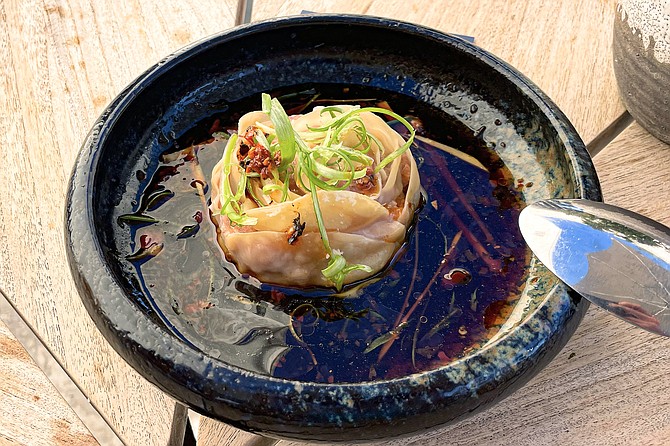
For those who haven’t yet found the time to check out the new-look Mingei International Museum, here’s a sure-fire way to make room in your busy schedule: by leveraging your appetite. Following a couple failed attempts to head over to Balboa Park spontaneously, I finally committed myself to a visit by making a reservation to dine at the museum’s recently opened restaurant, Artifact.
It's worth a visit to the Mingei, if only to see what they’ve done with the place. Among other things, a three-year, 55-million-dollar renovation has opened up the museum’s sight lines, better connecting it to the overall park experience. In particular, the entire ground floor is free and open to the public, and includes a view up to the museum’s priceless Chilhuly glass sculpture, which hangs in the bell tower, looking like an fantastical, many-tentacled, deep sea creature.
However, nearly half of the ground floor is now taken up by the dining room of Artifact, an eatery devised for the museum by San Diego’s Urban Kitchen Group, best known for its Cucina family of Italian restaurants. For fans of such places as Cucina Urbana or Cucina Sorella, the most noteworthy aspect of Artifact is its decidedly global menu.
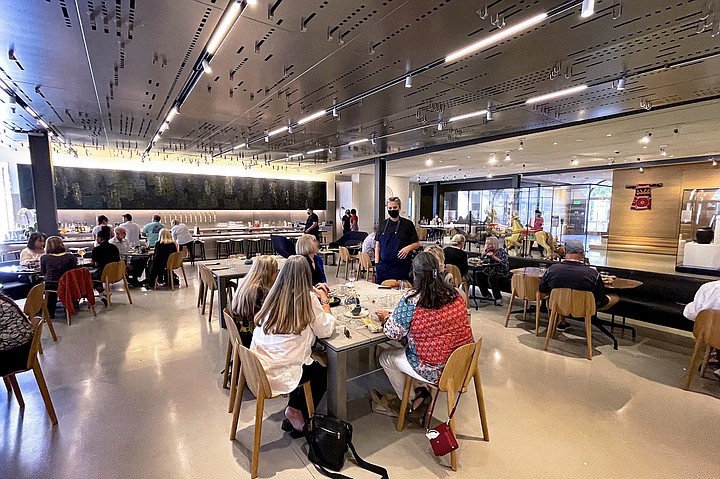
For example, the restaurant’s dedicated dumpling menu features both a Russian pelmeni and an Indian samosa. In the soup section, you’ll see a Persian ash reshteh, while an assortment of wraps features a take on South Africa’s peri peri chicken.
This logically follows the Mingei’s “international” designation — the museum, after all, boasts a collection of folk art and artifacts hailing from more than 160 countries. A couple new works, commissioned for the museum’s renovation, may even be seen in the Artifact dining room. “Truth and Beauty in Black,” a hand-felted mural by a Dutch artist hangs over the bar. Overhead, a piece called “Suspended Refrain” is a long sheet metal scroll that, if you could run it through a player piano, would play a Michel Legrand composition, “What Are You Doing The Rest Of Your Life,” music from 1969 film The Happy Ending.

Outside too, shaded dining tables on Artifact’s patio sit below the massive, mixed media artwork, “Variations on a Gold Theme,” created in the 1960s by San Diego artists Ellamarie and Jackson Wolley, considered masters in their day, when it came to enamel work.
For all these named art pieces, the true mission of the Mingei museum centers on the mingei concept, named by Japanese philosopher Yanagi Sōetsu to celebrate the crafts of “ordinary people.” In other words, to perceive the value in everyday objects often taken for granted by the capital-A art world: think pottery, textile designs, or the handmade dolls of myriad folk cultures.
This is the principle that seems to be at work in Artifact’s menu, which in effect holds up prepared food as an everyday item that may been seen in a more creative light. For better or worse.
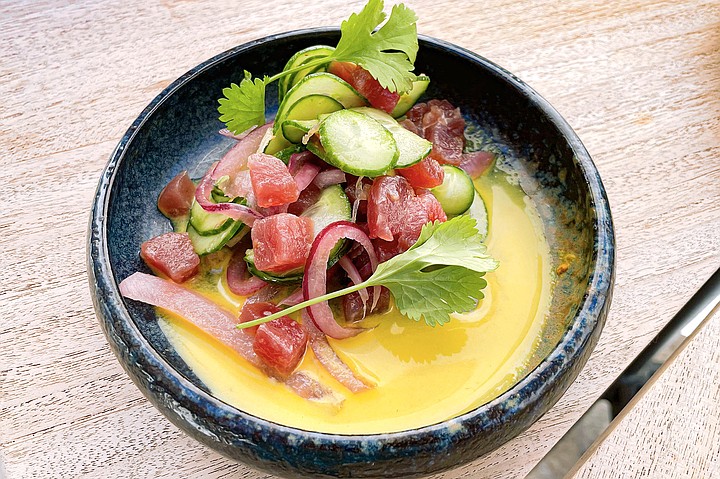
Take the pork shumai from that dumpling menu ($14), Artifact seizes upon the flower-like construction of the Chinese dumpling — familiar to fans of dim sum — and fashions extra dumpling wrapper to more closely resemble flower petals. Looking like a pork-filled rose, the dumpling creation is served with traditional shumai accompaniments such as scallions, ginger, black vinegar, and chili oil, plus the less typical, smoked black tea, lapsang souchang. Though quite tasty and visually appealing, as a matter of function, the extra wrapper “petals” dried out a bit, undermining the dumpling’s integrity.
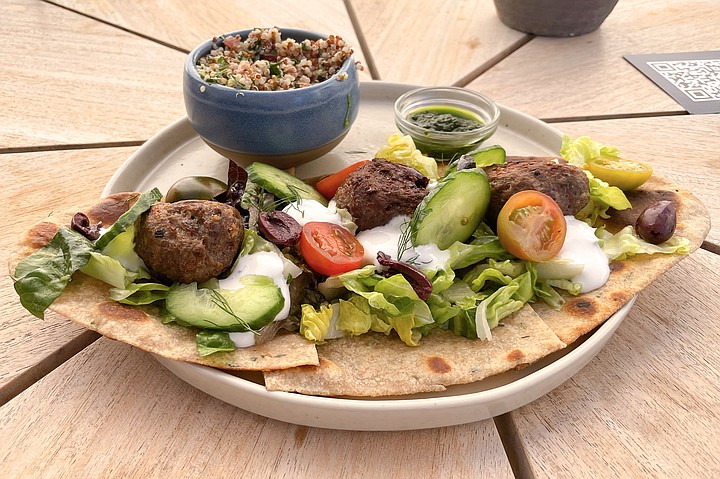
If we’re nitpicking, I encountered similar near-hits throughout the menu. A Peruvian inspired ahi ceviche ($16) in turmeric leche de tigre (tiger milk) tasted lovely, and the red tuna popped against the bright yellow liquid. But ultimately, the fish popped because it hadn’t actually been denatured (or “cooked”), so it ate more like an acidic poke salad.
On the wraps menu, a Middle Eastern lamb kibbeh ($22), flavored with cumin and allspice, was served as a flatbread, atop the Persian bread sangak. Again, the food looked and tasted fine, but function lagged. Its toppings — lamb meatballs, olives, cucumber slices, and cherry tomatoes — easily fell off the flatbread, slightly too crispy to fold over.
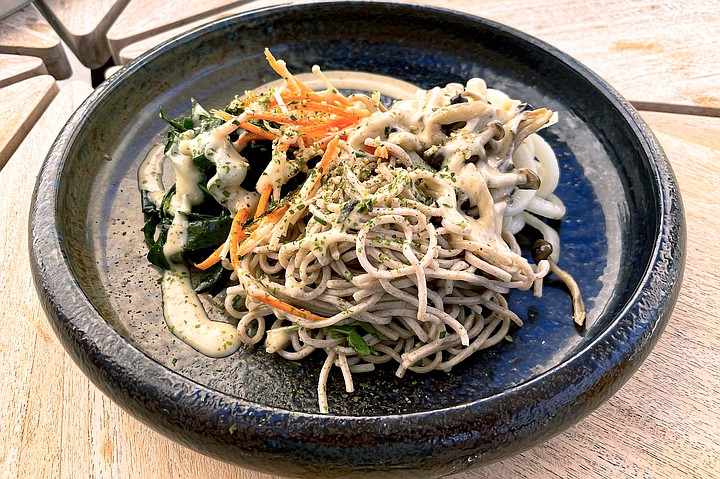
Despite minor imperfections, and coming to roughly $50 per person before drinks, I do think there’s plenty to like about Artifact, and much of it has to do with inspiration. To wit, my favorite dish, a buckwheat noodle salad ($16) with sesame collard greens, included “noodles” of pickled kohlrabi, a creative and flavorful addition that has me fondly remembering the meal days later. I have to conclude that everyday art is something that excels by being worked out over time, by building on traditions, and that a new restaurant drawing from so many sources will demand the sort of refinement only time allows. And we’re all looking for more of that.


For those who haven’t yet found the time to check out the new-look Mingei International Museum, here’s a sure-fire way to make room in your busy schedule: by leveraging your appetite. Following a couple failed attempts to head over to Balboa Park spontaneously, I finally committed myself to a visit by making a reservation to dine at the museum’s recently opened restaurant, Artifact.
It's worth a visit to the Mingei, if only to see what they’ve done with the place. Among other things, a three-year, 55-million-dollar renovation has opened up the museum’s sight lines, better connecting it to the overall park experience. In particular, the entire ground floor is free and open to the public, and includes a view up to the museum’s priceless Chilhuly glass sculpture, which hangs in the bell tower, looking like an fantastical, many-tentacled, deep sea creature.
However, nearly half of the ground floor is now taken up by the dining room of Artifact, an eatery devised for the museum by San Diego’s Urban Kitchen Group, best known for its Cucina family of Italian restaurants. For fans of such places as Cucina Urbana or Cucina Sorella, the most noteworthy aspect of Artifact is its decidedly global menu.

For example, the restaurant’s dedicated dumpling menu features both a Russian pelmeni and an Indian samosa. In the soup section, you’ll see a Persian ash reshteh, while an assortment of wraps features a take on South Africa’s peri peri chicken.
This logically follows the Mingei’s “international” designation — the museum, after all, boasts a collection of folk art and artifacts hailing from more than 160 countries. A couple new works, commissioned for the museum’s renovation, may even be seen in the Artifact dining room. “Truth and Beauty in Black,” a hand-felted mural by a Dutch artist hangs over the bar. Overhead, a piece called “Suspended Refrain” is a long sheet metal scroll that, if you could run it through a player piano, would play a Michel Legrand composition, “What Are You Doing The Rest Of Your Life,” music from 1969 film The Happy Ending.

Outside too, shaded dining tables on Artifact’s patio sit below the massive, mixed media artwork, “Variations on a Gold Theme,” created in the 1960s by San Diego artists Ellamarie and Jackson Wolley, considered masters in their day, when it came to enamel work.
For all these named art pieces, the true mission of the Mingei museum centers on the mingei concept, named by Japanese philosopher Yanagi Sōetsu to celebrate the crafts of “ordinary people.” In other words, to perceive the value in everyday objects often taken for granted by the capital-A art world: think pottery, textile designs, or the handmade dolls of myriad folk cultures.
This is the principle that seems to be at work in Artifact’s menu, which in effect holds up prepared food as an everyday item that may been seen in a more creative light. For better or worse.

Take the pork shumai from that dumpling menu ($14), Artifact seizes upon the flower-like construction of the Chinese dumpling — familiar to fans of dim sum — and fashions extra dumpling wrapper to more closely resemble flower petals. Looking like a pork-filled rose, the dumpling creation is served with traditional shumai accompaniments such as scallions, ginger, black vinegar, and chili oil, plus the less typical, smoked black tea, lapsang souchang. Though quite tasty and visually appealing, as a matter of function, the extra wrapper “petals” dried out a bit, undermining the dumpling’s integrity.

If we’re nitpicking, I encountered similar near-hits throughout the menu. A Peruvian inspired ahi ceviche ($16) in turmeric leche de tigre (tiger milk) tasted lovely, and the red tuna popped against the bright yellow liquid. But ultimately, the fish popped because it hadn’t actually been denatured (or “cooked”), so it ate more like an acidic poke salad.
On the wraps menu, a Middle Eastern lamb kibbeh ($22), flavored with cumin and allspice, was served as a flatbread, atop the Persian bread sangak. Again, the food looked and tasted fine, but function lagged. Its toppings — lamb meatballs, olives, cucumber slices, and cherry tomatoes — easily fell off the flatbread, slightly too crispy to fold over.

Despite minor imperfections, and coming to roughly $50 per person before drinks, I do think there’s plenty to like about Artifact, and much of it has to do with inspiration. To wit, my favorite dish, a buckwheat noodle salad ($16) with sesame collard greens, included “noodles” of pickled kohlrabi, a creative and flavorful addition that has me fondly remembering the meal days later. I have to conclude that everyday art is something that excels by being worked out over time, by building on traditions, and that a new restaurant drawing from so many sources will demand the sort of refinement only time allows. And we’re all looking for more of that.
Comments